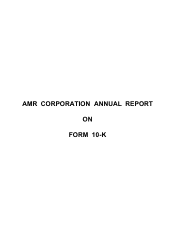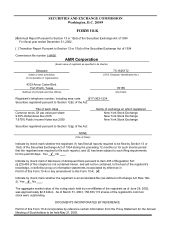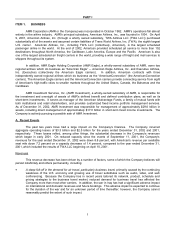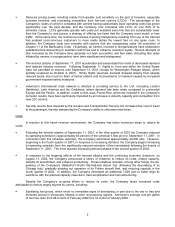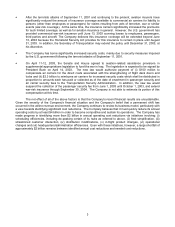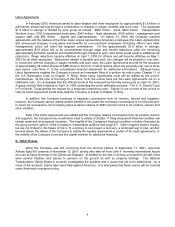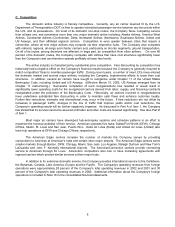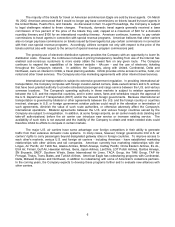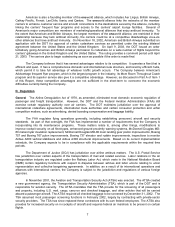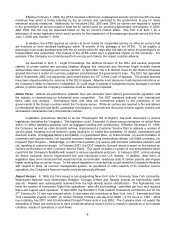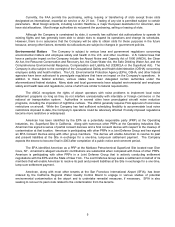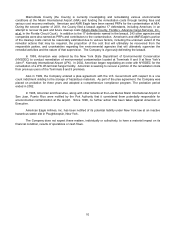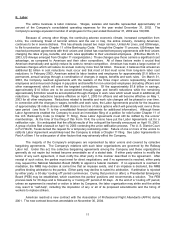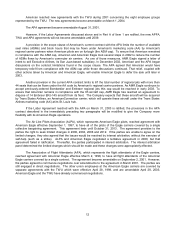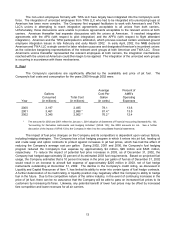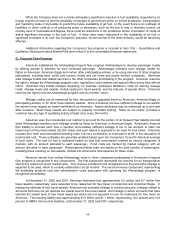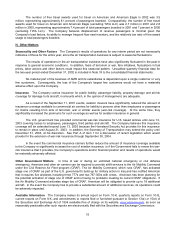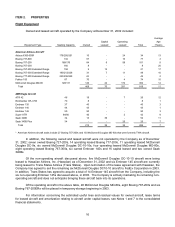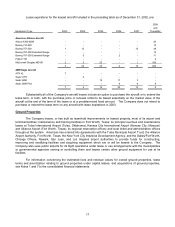American Airlines 2002 Annual Report Download - page 9
Download and view the complete annual report
Please find page 9 of the 2002 American Airlines annual report below. You can navigate through the pages in the report by either clicking on the pages listed below, or by using the keyword search tool below to find specific information within the annual report.
7
American is also a founding member of the oneworld alliance, which includes Aer Lingus, British Airways,
Cathay Pacific, Finnair, LanChile, Iberia, and Qantas. The oneworld alliance links the networks of the member
carriers to enhance customer service and smooth connections to the destinations served by the alliance, including
linking the carriers' frequent flyer programs and access to the carriers' airport lounge facilities. Several of
American's major competitors are members of marketing/operational alliances that enjoy antitrust immunity. To
the extent that American and British Airways, the largest members of the oneworld alliance, are restricted in their
relationship because they lack antitrust immunity, the carriers could be at a competitive disadvantage vis-a-vis
other alliances that have antitrust immunity. On November 18, 2002, American and British Airways submitted an
application with the DOT for approval of certain codeshare services as permitted under the existing bilateral
agreement between the United States and the United Kingdom. On April 9, 2003, the DOT issued an order
tentatively giving American and British Airways permission to codeshare on a wide number of flights beyond the
carriers’ gateways in the United Kingdom and the United States. The ruling provides a comment period until April
21, 2003. The carriers plan to begin codesharing as soon as possible if the order is made final.
The Company believes that it has several advantages relative to its competition. It operates a fleet that is
efficient and quiet. It has a comprehensive domestic and international route structure, anchored by efficient hubs,
which permit it to take full advantage of whatever traffic growth occurs. The Company believes American's
AAdvantage frequent flyer program, which is the largest program in the industry, its More Room Throughout Coach
program and its superior service also give it a competitive advantage. However, as discussed in Part A of Item 1
of this Report, these competitive advantages are not sufficient in the short-term to overcome the economic
difficulties currently facing the Company.
D. Regulation
General The Airline Deregulation Act of 1978, as amended, eliminated most domestic economic regulation of
passenger and freight transportation. However, the DOT and the Federal Aviation Administration (FAA) still
exercise certain regulatory authority over air carriers. The DOT maintains jurisdiction over the approval of
international codeshare agreements, international route authorities and certain consumer protection and unfair
competition matters, such as advertising, denied boarding compensation and baggage liability.
The FAA regulates flying operations generally, including establishing personnel, aircraft and security
standards. As part of that oversight, the FAA has implemented a number of requirements that the Company is
incorporating into its maintenance programs. These matters relate to, among other things, modifications to
improve cockpit security on all fleet-types, enhanced ground proximity warning systems, McDonnell Douglas MD-
80 metal-mylar insulation replacement, McDonnell Douglas MD-80 main landing gear piston improvements, Boeing
757 and Boeing 767 pylon improvements, Boeing 737 elevator and rudder improvements, inspections to monitor
Airbus A300 vertical stabilizers and Airbus A300 structural improvements. Based on its current implementation
schedule, the Company expects to be in compliance with the applicable requirements within the required time
periods.
The Department of Justice (DOJ) has jurisdiction over airline antitrust matters. The U.S. Postal Service
has jurisdiction over certain aspects of the transportation of mail and related services. Labor relations in the air
transportation industry are regulated under the Railway Labor Act, which vests in the National Mediation Board
(NMB) certain regulatory functions with respect to disputes between airlines and labor unions relating to union
representation and collective bargaining agreements. In addition, as a result of its international operations and
alliances with international carriers, the Company is subject to the jurisdiction and regulations of various foreign
agencies.
In November 2001, the Aviation and Transportation Security Act (ATSA) was enacted. The ATSA created
a new government agency, the Transportation Security Administration (TSA), which is part of the DOT and is
responsible for aviation security. The ATSA mandates that the TSA provide for the screening of all passengers
and property, including U.S. mail, cargo, carry-on and checked baggage, and other articles that will be carried
aboard a passenger aircraft. The ATSA required all checked baggage to be screened by December 31, 2002. The
TSA assumed most passenger screening functions in February 2002, largely by contracting with private-sector
security providers. The TSA has since replaced these contractors with its own federal employees. The ATSA also
provides for increased security on in cockpits of aircraft and requires federal air marshals to be present on certain
flights.

